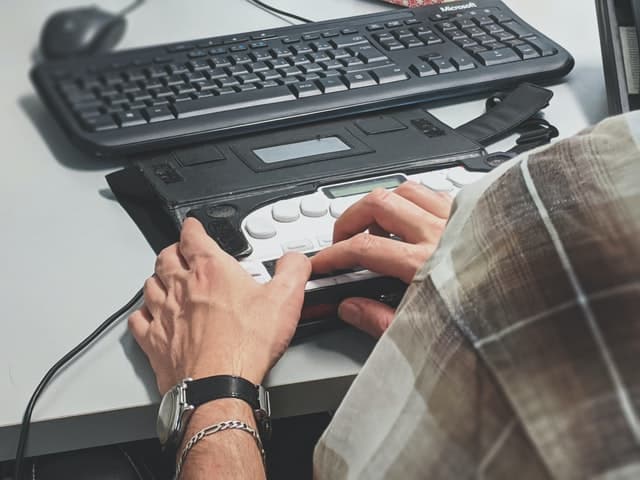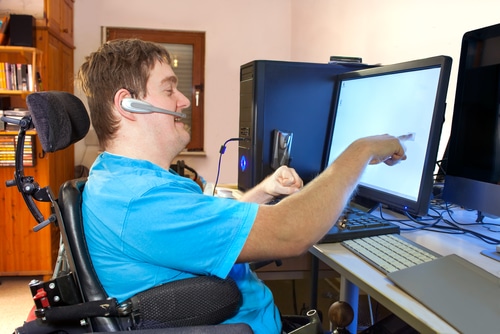Global Accessibility Awareness Day is marked each year on the third Thursday of May, which is today!
Blue Badge Insurance wanted to ensure we joined the conversation around digital accessibility and inclusivity, so in this new article we look at who’s impacted by a lack of accessibility in the digital world. We also explore what can be done to improve it.
What is Global Accessibility Awareness Day?
Global Accessibility Awareness Day launched in May 2012, after being inspired by one viral blog post.
The worldwide celebration’s official website says its aim is to “get everyone talking, thinking and learning about digital access and inclusion” for people living with disability.
It explains further that “every user deserves a first-rate digital experience on the web. Someone with a disability must be able to experience web-based services, content and other digital products with the same successful outcome as those without disabilities.
“This awareness and commitment to inclusion is the goal of Global Accessibility Awareness Day, a global event that shines a light on digital access and inclusion for people with disabilities.”
As Australia’s leading disability insurance specialist, we know how important assistive technology and digital access can be when it comes to the quality of everyday life.
Who does Global Accessibility Awareness Day help?
Around 1 in 6 Australians (roughly 4.4 million) are living with disability. Not all of these disabilities will affect access to digital resources and content, but many of them will. Global Accessibility Awareness Day aims to highlight the difficulties that we can face in gaining equal access to digital products.
Here are some of the more common disabilities, and how they might impact digital experience:
Visual impairment
Visual impairment encompasses a wide range of disabilities. These range from colour blindness and glaucoma right through to full blindness.
Some people may rely on screen readers to navigate websites and then not be able to “see” or interpret the contents of images. Others might simply skip websites or apps where there’s poor contrast between elements, diminishing their digital experience.
Some people living with visual impairment need assistive technology to help them access apps, websites, and content as they aren’t able to use a mouse to interact with a screen.

Hearing impairment
People who have hearing impairments can struggle to interact with audio elements of digital content, which easily causes frustration.
Videos, podcasts, and even video presentations in the corporate environment are all inaccessible in their pure form to those with hearing impairments. Unless, of course, steps are taken to make digital content with audio elements more inclusive.
Physical or motor impairments
Depending on the disability (or disabilities), some people with physical or motor impairments may also find they’re unable to access digital products in the same way as those living without disability.
For instance, people who are unable to control their hand movements cannot access websites and content easily. Typing, using navigational devices like mouses and keyboards, scrolling, pausing, selecting or closing pop ups and so on all require fine motor control and deft movements.
Cognitive differences
Those with cognitive impairments or sensory processing problems might find that some digital products are inaccessible.
This could be because the interface is too cluttered, the language too complicated, or even because bright colours, moving images or videos, and loud sounds are overwhelming. Which makes these elements not only difficult to process on their own, but extra difficult (and often impossible) to process concurrently.

Global Accessibility Awareness Day highlights inclusive solutions
Of course, the above are only some examples of situations in which digital access for people living with disability might be limited. As disability is so unique to each person, there are numerous other instances where digital products are not accessible or exclusive.
Global Accessibility Awareness Day aims to change that. As part of its mission, it highlights ways in which the digital experience can be made more inclusive, either through assistive technology or through modifications to the digital experience on a larger scale.
Here’s what we’ve learned from Global Accessibility Awareness Day, of how the digital experience can be improved for those living with disability.
What web developers and content owners can do
If you’re building a website, creating digital content, or similar there are a few things you can do to make your digital products more accessible:
- Include descriptions of any images so screen readers can describe the content to vision impaired users
- Ensure any content with audio elements has closed captions, subtitles, or access to a written script
- Keep your use of language understandable and plain wherever possible
- Try to keep the user interface and experience plain, uncluttered, and easy to navigate
Assistive technology options
Some people require assistive technology so they can access digital properties more easily, with a wide variety available for this purpose today. Global Accessibility Awareness Day helps put a spotlight on some of them.
Here are some examples of assistive technology which improves digital access.
1. Screen readers.
This technology converts words on a screen to a digitised voice, allowing blind or visually impaired people to read the words.
2. Screen magnification technology.
This allows people to control the size of text or other elements. It doesn’t just zoom, but instead keeps the rest of the screen at the same scale. It’s similar to holding a handheld magnifying glass over a section of a content.
3. Speech recognition software.
This allows people to convert spoken words into text. It can be useful for people with visual impairment, cognitive impairment, and physical impairments.
4. Amazon Echo.
Amazon Echo recently introduced a feature where users can hold up an item and ask Alexa what it is. Echo then uses AI (artificial intelligence) to identify the object. This is particularly helpful for those living with blindness or visual impairment.
5. Alternative input devices.
This range of technology offers users alternatives to a mouse and/or keyboard. Included under this umbrella term are technologies that allow people to navigate websites through eye or head movement.
6. Proofreading software.
This technology goes over and above what a normal “spell check” would. It checks for grammatical problems and frequent misspellings of words such as they’re and their. It can also help with punctuation, allowing people with learning disorders such as dyslexia to improve their written communication.
These are just some of the assistive technology options available. And for many people NDIS funding enables affordable access to them. Read about how the NDIA determines what are reasonable and necessary supports here. Wondering if you can become an NDIS participant? Here are the steps to access the NDIS.
As Global Accessibility Awareness Day highlights, there are many more examples of assistive technology making life easier for global citizens. However, there’s still a lot of work to be done to improve digital accessibility.
Disability-specific insurance
Blue Badge Insurance isn’t just another insurance provider – we truly understand your independence and mobility needs. We go the extra mile to make sure your crucial mobility equipment and/or vehicles are properly covered. Check out our insurance offering for disability parking permit holders here… You could be eligible for up to 25% discount on your premiums.
And to help you understand more about us, find out why we’re different in our article 5 Ways Blue Badge Insurance Differs From Traditional Insurers
Global Accessibility Awareness Day – over to you
What’s your experience of digital access, and how do you think the digital world can become more inclusive? Let us know by leaving a comment.








